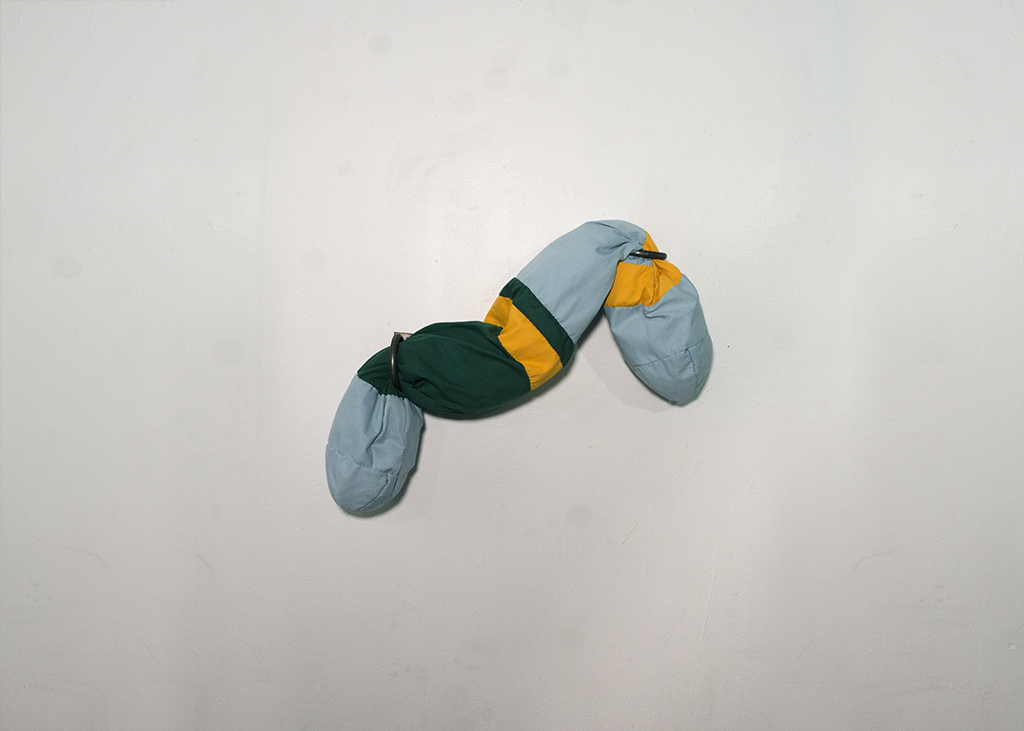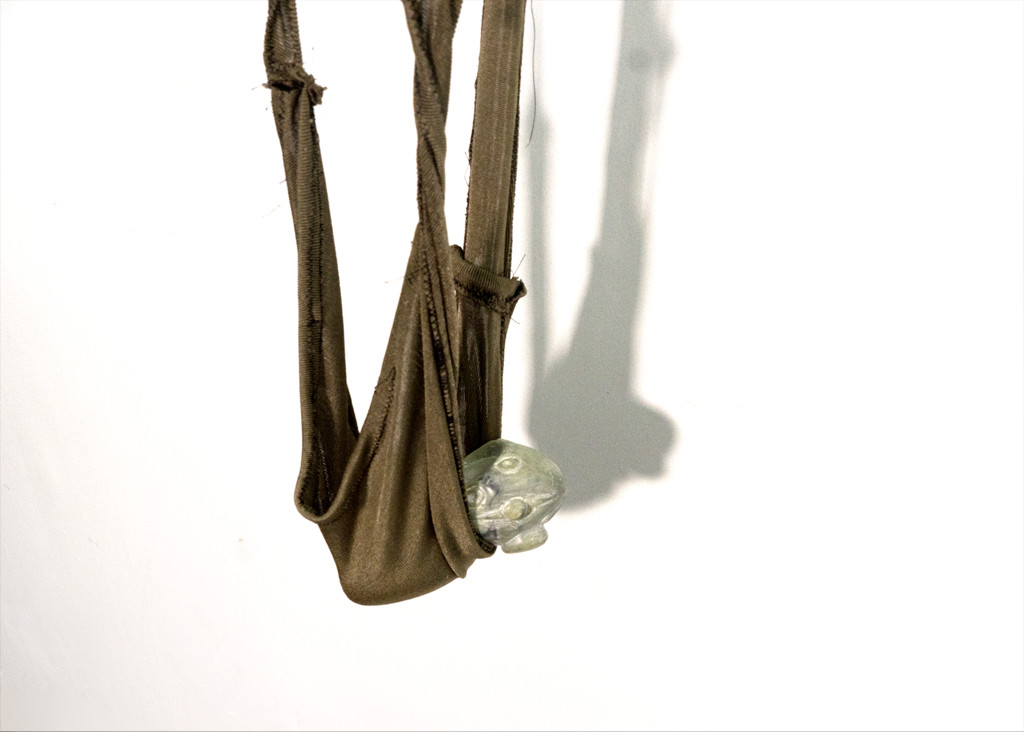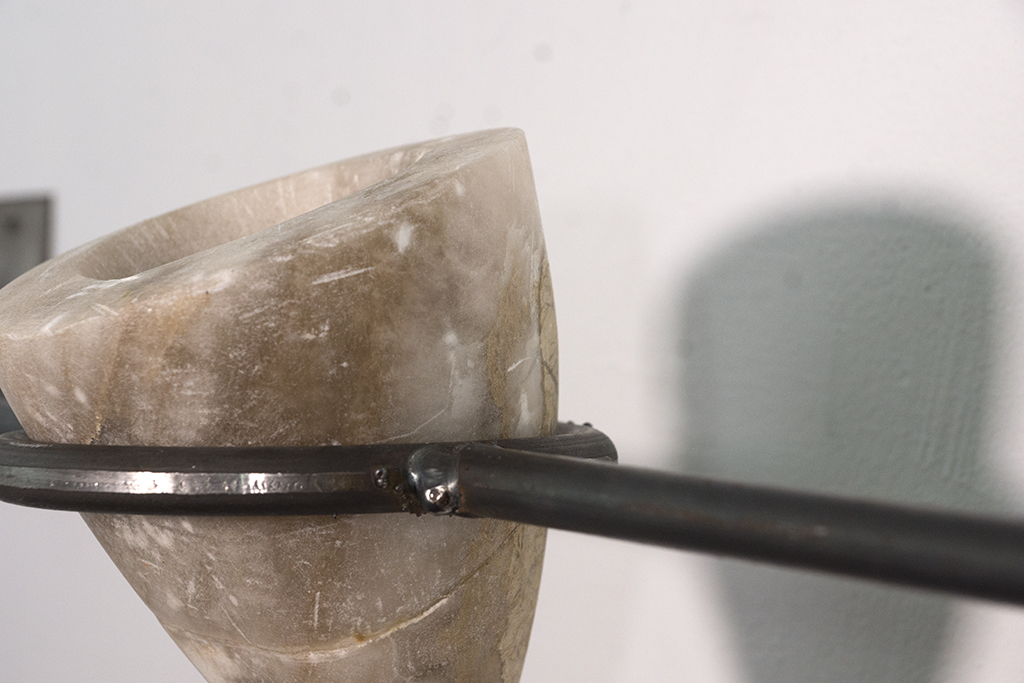www.ingridhoerrner.com

10,000 mg, 2018
Fabric, Fiber fill, Steel
18 in x 24 in x 5 in
This sculpture explores the relationship between the display object and the displayed object using a soft form reminiscent of pharmaceutical drugs. The pliable soft sculpture is visibly manipulated by oppressive steel rings, which hold the sculpture to the wall.

To Feel One’s Own Weight, 2018
Fabric, Soapstone, Steel
30 in x 40 in x 6 in
This project began with two recognizable children’s toys: a rubber duck and “Bug-Out Bob" which were then slightly melted and deformed using a torch. I used these objects as models to carve soapstone representations. The resulting wonky, sad figures evoke sympathy, leading the viewer to identify with them and the forces being acted upon them in the supporting slings which precariously cradle them.

To Feel One’s Own Weight (detail), 2018
Fabric, Soapstone, Steel
30 in x 40 in x 6 in

The Funnel of Betrayal I, 2018
Alabaster, Steel, Fabric, Fiberfill
54 in x 5 in x 8 in
This project synthesizes a body of research on the visual language used in anti-psychiatric texts of the 1960s and 70s. The result is a material examination of Erving Goffman’s metaphor of “the funnel of betrayal” used to describe the process of institutionalization.

The Funnel of Betrayal I (detail), 2018
Alabaster, Steel, Fabric, Fiberfill
54 in x 5 in x 8 in

Only a Cork Floating on the Ocean, 2019
Steel, Moving blanket, Stretch satin, Recycled polyurethane foam, Sand
28 in x 71 in x 28 in
This work physically iterates one of the theory central to R.D. Laing’s 1960 book The Divided Self which posits that the primary mechanism of psychosis is a widening divide between what the author calls the “embodied” and “unembodied” self, or, the physical body and the metaphysical place where an individual identifies their true self. This sculpture weighs as much as my body and is designed to be moved, dragging behind the viewer, the literalize this divide and subsequently confront it.
Through my practice, I explore the often ineffable experience of emotional trauma through the
visual metaphor used to speak about it. I am intensely interested in the common practice of
defaulting to simile and metaphor when discussing the personal experience of being. I find it
troubling that there are experiences where words cannot suffice. As a result, I find myself
clinging to the words we use when we must speak about something, although we are not sure
how. My sculptures often consist of a dismantled metaphor, creating a parallel between the
human experience and the relationships between hard and soft materials.
Using carved stone, I am able to create a precious-seeming object which receives projected
sympathy from the audience. When compared to the soft fabric sculptures alongside them,
strangled by metal rings, the weight and durability of the stone work is emphasized. By carving
a representation of an object, I memorialize it in its current form, creating a reverent snapshot
of an object in its time of trauma.
I tend to work with sculpture in two modes: the display object and the displayed object. Most
of my sculptures can be broken down into these two elements. My work examines these
relationships by changing materiality, leaving the displayed object seeming either crushed and
suffocated, or protected and cradled by its display mechanism depending on the softness or
hardness of the material of the work. The supporting structures I create force their objects into an
ambiguous state of flux.


